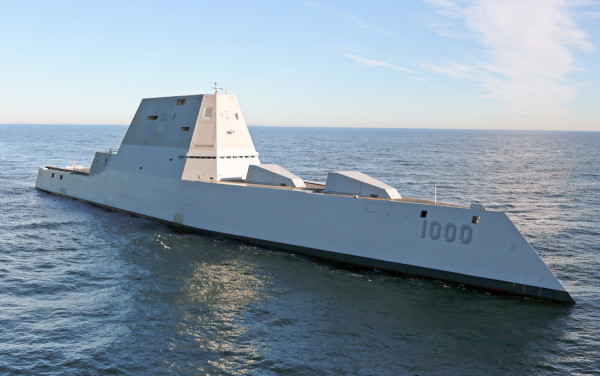

It’s been nearly four years since the $7.8 billion USS Zumwalt (DDG 1000) was first commissioned in Baltimore, Maryland in October 2016, but the Navy’s first stealth destroyer is almost finally ready to actually see combat.
Defense News reports that the Zumwalt is “on track” to have its combat system installation completed and delivered “within days,” a long-awaited milestone since BAE System was initially awarded a $192 million contract to deliver combat systems to both the Zumwalt and its sister ship, the USS Michael Monsoor, in November 2016.
Originally called “the largest and most technologically advanced surface combatant in the world,” the Zumwalt was originally designed to offer naval gunfire support to Marines ashore with its twin 15mm Advanced Gun Systems and GPS-guided Long Range Land Attack Projectile (LRLAP) shells.
But with the vessel long plagued by cost overruns and technical issues in the intervening years, the cost of the LRLAP skyrocketed from $50,000 to $566,000 apiece, prompting the Navy to not just reduce its Zumwalt-class destroyer buy from 28 hulls to just three but transitioned the Zumwalt itself from shore bombardment to anti-ship surface warfare missions.
As a result, the Zumwalt now comes laden with ship-killer systems like the Maritime Strike Tomahawk and SM-6, Defense News notes. The $505 million Advanced Gun System now stands “all but abandoned” by the Navy after being delivered to the service in an “inactive state” and only expected to reach initial operation capacity in September 2021.
That the Zumwalt’s combat systems are finally ready to rumble means little for the vessel’s actual combat effectiveness. The latest evaluation of the Zumwalt’s self-defense systems conducted by the Pentagon’s operational testing and evaluation arm in fiscal year 2019 revealed “severe problems” during the vessel’s Self-Defense Test Ship events that will “adversely affect the operational effectiveness of the combat system if not corrected.”
Those self-defense systems include the Evolved Sea Sparrow Missile (ESSM) Block 1 short-range missile interceptor, the Cooperative Engagement Capability ship-to-ship communications interface, and the new Multi-Function Radar (MFR/SPY-3) that’s been giving the USS Gerald R. Ford aircraft carrier a headache for years.
“The Navy has put the test program on hold and is currently working to identify the root cause of these problems,” the OT&E report reads. “The DDG 1000 self-defense test program is at risk of being inadequate if the six remaining SDTS events are not completed.”
According to Defense News, the Monsoor is on pace to see its combat system activation completed by the second quarter of 2020, with the third Zumwalt-class destroyer, the USS Lyndon B. Johnson, scheduled for delivery to the Navy by December 2020.
